 Though some 5,350 voters are known to have voted in the city of Stoughton in Dane County, Wisconsin on Tuesday, just 16 of those voters were interested in voting in a local ballot referendum calling for an amendment to the U.S. Constitution to help overturn the infamous Citizens United decision --- at least according to the results reported by paper ballot optical-scan computer tabulators there.
Though some 5,350 voters are known to have voted in the city of Stoughton in Dane County, Wisconsin on Tuesday, just 16 of those voters were interested in voting in a local ballot referendum calling for an amendment to the U.S. Constitution to help overturn the infamous Citizens United decision --- at least according to the results reported by paper ballot optical-scan computer tabulators there.
"A malfunction with the voting machines in Stoughton Tuesday led to an incomplete outcome of the city's referendum on whether to amend the U.S. Constitution, Stoughton clerk Lana Kropf said," according to a terse and somewhat cryptic report in the Wisconsin State Journal on Thursday.
The city's ES&S DS200 paper ballot optical-scanners (a computer tabulation system plagued with problems in many states over the years) reported zero votes for the initiative in five of the city's six voting wards, and just 16 votes (7 Yes, 9 No) in the other.
"Never in my years working in clerks' offices have I seen something like this," Kropf told the Journal.
The initiative in question was added to the ballot after citizens gathered enough signatures last July to have it included on the November ballot. According to the wording of the measure, it seeks "to reclaim democracy from the expansion of corporate personhood rights and the corrupting influence of unregulated political contributions and spending." It is similar to referenda passed overwhelmingly in other WI communities.
"Last Tuesday, nearly 5,350 good citizens of Stoughton went to the polls," writes Karen McKim of the progressive Wisconsin Grassroots Network. "If you believe the city's voting machines, exactly 16 of them had an opinion they cared to express on the matter. The rest thought 'Whatevs' and left the referendum blank."
She adds: "Fortunately, no one believes the city's voting machines"...

The referendum was based on a Move to Amend campaign calling for a 28th Amendment to the U.S. Constitution. The version of the Amendment on Stoughton's ballot reads:
2. Money is not speech, and therefore regulating political contributions and spending is not equivalent to limiting political speech.
The city of Stoughton's measure was the only item to appear on the back of the hand-marked paper ballots in Stoughton last week. But is it possible that only 16 voters out of more than 5,000 turned over the ballot to notice it and/or had an opinion on the resolution either way?
Well, the good news is, we now appear to know what actually happened and should be able to determine what last Tuesday's voters really thought about the referendum.
The bad news is, whatever caused this problem could easily have affected any number of other elections in any number of other places both in Wisconsin and elsewhere where identical and similar tabulation systems are used. Without a hand-count of those ballots, it's just as likely that nobody would ever notice a similar problem.
McKim of the progressive Wisconsin Grassroots Network offered a terrific piece explaining the problem and why it appears to have happened in Stoughton, according to local election officials:

When Stoughton's ballots came back from the printers, the referendum was perfectly placed on the ballot right where it was intended to be. However, the person who programmed the sticks wrote instructions that told the machine to look at the areas two index marks below the referendum, in white space. That explains the thousands of apparently blank ballots.
But what explains the 16 votes? Did 16 of Stoughton's voters know they could get their vote counted by making a black mark an inch below the bubbles that everyone else was filling in? Nope. Truth is, they were voting so enthusiastically for someone on the front of the ballot that their votes were bleeding through the paper into the white space below the referendum on the back.
Bleed-though usually isn't a problem, Dane County Clerk Scott McDonell told me today, because when two-sided ballots are designed, the bubbles are placed so that any bleed-through from particularly heavily marked votes will fall into white space on the other side--as these marks did. Usually, the machines are not looking for votes in the white spaces. Not usually, but they did on Tuesday in Stoughton.
Presuming the explanation from officials is accurate, McKim goes on to speculate about a few potential reasons it might have occurred in Stoughton:
- The previous veteran City Clerk resigned around the time that the petitions were handed in and the measure was added to the ballot and someone less experienced took over;
- The late addition to the ballot and confusion about WI Republicans struck-down, then back on, then back off Photo ID voting restrictions may have exacerbated the problem by eating in to time normally spent proof-reading ballots and testing computer tabulators;
- The machines may not have gone through their mandated pre-election tests at all, even though the City Clerk claims they did.
That last seems the most likely and troubling, since it's difficult to see how the issue as explained would not have been discovered during pre-election Logic and Accuracy (L&A) testing. Poor L&A testing, or complete lack thereof, has been a fairly regular problem with electronic voting and tabulation systems over the years in the U.S.
As McKim notes, while the City Clerk is claiming testing was done, "No citizens were present at the public pre-election voting machine test to ensure that it was done properly." She further explains: "I don't see any way that test could have been conducted properly and not discovered the faulty programming."
While the Wisconsin Grassroots Network did observe pre-election testing in other towns, McKim says that nobody did so in Stoughton. "Citizens have got to do our bit," she appropriately cautions. "We cannot relentlessly demand transparency in government and relentlessly fail to show up for things like public demonstrations of the voting machines' ability to produce --- or in this case, not produce --- an error-free count."
Fortunately, the problem this time in Stoughton --- whether the result of malfunction, malfeasance or misfeasance --- was quickly noticed and should soon be easily rectified. A hand-count of those hand-marked paper ballot will take place on Monday to determine the real results of the referendum. Luckily, the town votes on paper. If it didn't, there would be no way to ever determine the actual intent of the voters.
But the issue, even as explained above, also reveals once again how easy it is to "trick" these systems --- even computer-tabulated paper-ballots systems --- via simple, standard ballot programming procedures...not that anyone would ever do such a thing either accidentally or on purpose.
The very same failed ES&S DS200 tabulation systems are used in Florida, Ohio, New York and other states in addition to Wisconsin. As The BRAD BLOG reported in 2012 after the company's manufacturer ES&S confirmed some of the problems that appear to have led to thousands of votes being mistallied in New York's 2010 election, "Over 4 million registered voters in FL, more than 6.5 million in NY, over 1 million in OH, and voters in more than 50 WI municipalities...are set to have their votes tallied --- accurately or otherwise --- by the failed ES&S DS200" during that year's Presidential election.
Optical-scan paper ballot systems made by other manufacturers have failed in similar and even more spectacular fashion. Occasionally it gets noticed, as it did, for example, in Palm Beach County, FL's municipal elections in March of 2012, when, luckily, a sharp-eyed election official noticed that the op-scan paper ballot system declared incorrect "winners" in four different races. Only a hand-count there was able to determine the real winners of the contests. (The manufacturer of that system, used in dozens of states, was forced to admit the failure was due to a "bug" present in all of the company's voting and tabulation systems --- many of which are also used in Wisconsin.)
"If the hand count goes well on Monday," McKim notes (presuming the chain of custody of the hand-marked paper ballots in Stoughton has been secure since Election Day), "the municipal referendum results will be final and certified --- and more guaranteed-accurate than anything else on the ballot."
She then offers this important, cautionary, spot-on reminder:
Bingo.
[Hat-tip WI election integrity champ John Washburn]
UPDATE 11/11/2014: While the Lana Kropf, the City Clerk of Stoughton, has not responded to our email queries, the Dane County Clerk's election website has finally been updated with some new numbers following the hand-count of the referendum which was supposed to begin on Monday...

They show the referendum easily passing 4440 to 992. It's unclear why Wards 9 through 11 show zero votes, however. If we can learn more, we'll update again.
(Snail mail support to "Brad Friedman, 7095 Hollywood Blvd., #594 Los Angeles, CA 90028" always welcome too!)
|


 'Green News Report' 12/4/25
'Green News Report' 12/4/25
 A 'Flashing Red Light
A 'Flashing Red Light 'Fog of War'?: Hegseth, War Crimes and the DoD's 'Politicization Death Spiral': 'BradCast' 12/2/25
'Fog of War'?: Hegseth, War Crimes and the DoD's 'Politicization Death Spiral': 'BradCast' 12/2/25 'Green News Report' 12/2/25
'Green News Report' 12/2/25 Follow the
Follow the  Sunday 'Bootlicker' Toons
Sunday 'Bootlicker' Toons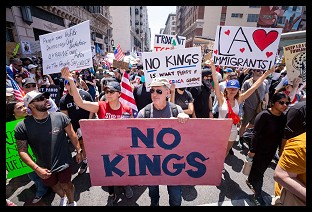 With Thanks, No Kings and Good Cheer
With Thanks, No Kings and Good Cheer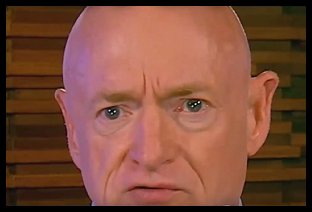 Presidential Illegality and the Duty to Disobey
Presidential Illegality and the Duty to Disobey Sunday 'Leave 'em in Stitches' Toons
Sunday 'Leave 'em in Stitches' Toons President of United States Calls for Killing Democratic Officials: 'BradCast' 11/20/25
President of United States Calls for Killing Democratic Officials: 'BradCast' 11/20/25 'Green News Report' 11/20/25
'Green News Report' 11/20/25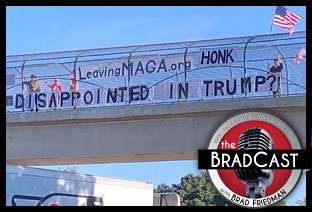 Is MAGA Finally Beginning to Fall Apart?: 'BradCast' 11/19/25
Is MAGA Finally Beginning to Fall Apart?: 'BradCast' 11/19/25 Trump's Terrible, Horrible, No Good, Very Bad Day (Week? Month? Year? Life?): 'BradCast' 11/18/25
Trump's Terrible, Horrible, No Good, Very Bad Day (Week? Month? Year? Life?): 'BradCast' 11/18/25 'Green News Report' 11/18/25
'Green News Report' 11/18/25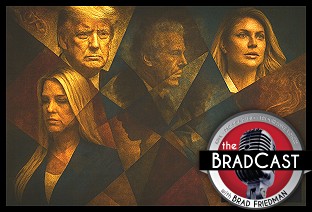 A Kaleidoscope of Trump Corruption: 'BradCast' 11/17/25
A Kaleidoscope of Trump Corruption: 'BradCast' 11/17/25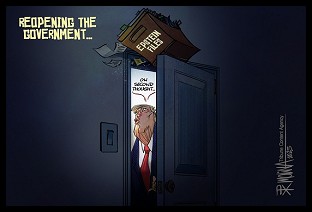 Sunday 'Back to Business' Toons
Sunday 'Back to Business' Toons Trump DOJ Takes Stand for Voting Whites in CA: 'BradCast' 11/13/25
Trump DOJ Takes Stand for Voting Whites in CA: 'BradCast' 11/13/25 'Green News Report' 11/13/25
'Green News Report' 11/13/25 Mamdani's 'Surprisingly Affordable' Afford-ability Agenda for NYC: 'BradCast' 11/12
Mamdani's 'Surprisingly Affordable' Afford-ability Agenda for NYC: 'BradCast' 11/12 After the Shutdown and Before the Next One: 'BradCast' 11/11/25
After the Shutdown and Before the Next One: 'BradCast' 11/11/25 2025 Election Victories; Also: 7 Dems, 1 Indie End Shutdown: 'BradCast' 11/10/25
2025 Election Victories; Also: 7 Dems, 1 Indie End Shutdown: 'BradCast' 11/10/25 'We Can See Light at the End of the Tunnel' After Election 2025: 'BradCast' 11/6/25
'We Can See Light at the End of the Tunnel' After Election 2025: 'BradCast' 11/6/25 BLUE WAVE! Dems Win Everything Everywhere All at Once: 'BradCast' 11/5/25
BLUE WAVE! Dems Win Everything Everywhere All at Once: 'BradCast' 11/5/25 Repub Thuggery As Americans Vote: 'BradCast' 11/4/25
Repub Thuggery As Americans Vote: 'BradCast' 11/4/25 Last Call(s) Before Election Day 2025: 'BradCast' 11/3/25
Last Call(s) Before Election Day 2025: 'BradCast' 11/3/25 A Pretty Weak 'Strongman': 'BradCast' 10/30/25
A Pretty Weak 'Strongman': 'BradCast' 10/30/25
 VA GOP VOTER REG FRAUDSTER OFF HOOK
VA GOP VOTER REG FRAUDSTER OFF HOOK Criminal GOP Voter Registration Fraud Probe Expanding in VA
Criminal GOP Voter Registration Fraud Probe Expanding in VA DOJ PROBE SOUGHT AFTER VA ARREST
DOJ PROBE SOUGHT AFTER VA ARREST Arrest in VA: GOP Voter Reg Scandal Widens
Arrest in VA: GOP Voter Reg Scandal Widens ALL TOGETHER: ROVE, SPROUL, KOCHS, RNC
ALL TOGETHER: ROVE, SPROUL, KOCHS, RNC LATimes: RNC's 'Fired' Sproul Working for Repubs in 'as Many as 30 States'
LATimes: RNC's 'Fired' Sproul Working for Repubs in 'as Many as 30 States' 'Fired' Sproul Group 'Cloned', Still Working for Republicans in At Least 10 States
'Fired' Sproul Group 'Cloned', Still Working for Republicans in At Least 10 States FINALLY: FOX ON GOP REG FRAUD SCANDAL
FINALLY: FOX ON GOP REG FRAUD SCANDAL COLORADO FOLLOWS FLORIDA WITH GOP CRIMINAL INVESTIGATION
COLORADO FOLLOWS FLORIDA WITH GOP CRIMINAL INVESTIGATION CRIMINAL PROBE LAUNCHED INTO GOP VOTER REGISTRATION FRAUD SCANDAL IN FL
CRIMINAL PROBE LAUNCHED INTO GOP VOTER REGISTRATION FRAUD SCANDAL IN FL Brad Breaks PA Photo ID & GOP Registration Fraud Scandal News on Hartmann TV
Brad Breaks PA Photo ID & GOP Registration Fraud Scandal News on Hartmann TV  CAUGHT ON TAPE: COORDINATED NATIONWIDE GOP VOTER REG SCAM
CAUGHT ON TAPE: COORDINATED NATIONWIDE GOP VOTER REG SCAM CRIMINAL ELECTION FRAUD COMPLAINT FILED AGAINST GOP 'FRAUD' FIRM
CRIMINAL ELECTION FRAUD COMPLAINT FILED AGAINST GOP 'FRAUD' FIRM RICK SCOTT GETS ROLLED IN GOP REGISTRATION FRAUD SCANDAL
RICK SCOTT GETS ROLLED IN GOP REGISTRATION FRAUD SCANDAL VIDEO: Brad Breaks GOP Reg Fraud Scandal on Hartmann TV
VIDEO: Brad Breaks GOP Reg Fraud Scandal on Hartmann TV RNC FIRES NATIONAL VOTER REGISTRATION FIRM FOR FRAUD
RNC FIRES NATIONAL VOTER REGISTRATION FIRM FOR FRAUD EXCLUSIVE: Intvw w/ FL Official Who First Discovered GOP Reg Fraud
EXCLUSIVE: Intvw w/ FL Official Who First Discovered GOP Reg Fraud GOP REGISTRATION FRAUD FOUND IN FL
GOP REGISTRATION FRAUD FOUND IN FL

































